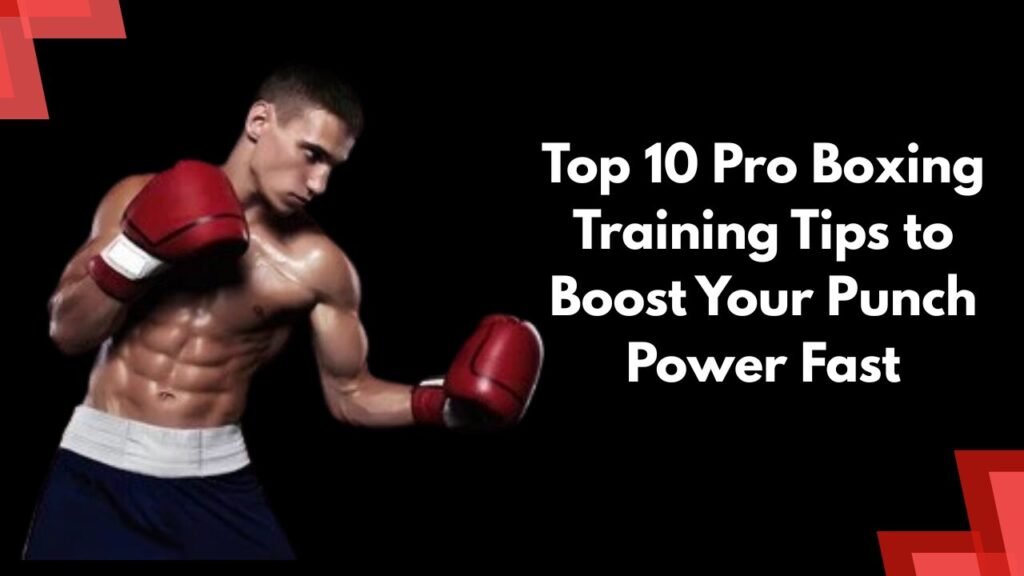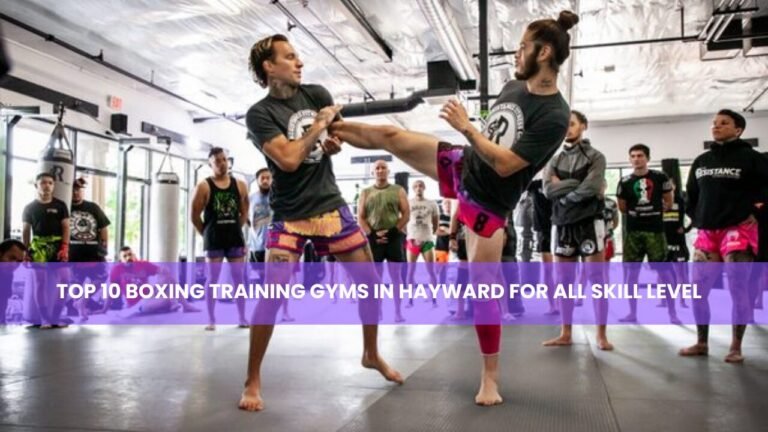Whether you are just stepping into the boxing ring for the very first time or you are already an experienced fighter aiming to refine your skills, one thing remains constant: the ability to generate real punching power is a game-changer. Punching power is not simply about raw muscle strength. It is a combination of precise technique, explosive movement, strategic conditioning, and training your body as a complete system.
When you watch professional fighters land knockout shots, it may seem like magic. But in reality, that power is built through disciplined training, biomechanics, and years of mastering the fundamentals. The good news is, you do not have to wait years to start improving. By following the right strategies, you can start feeling noticeable improvements in your punching ability within weeks.
In this guide, we will walk through 10 professional boxing training tips that have been tried and tested by elite fighters and top coaches worldwide. These tips go far beyond the gym floor they involve technical awareness, smart conditioning, nutrition, and ring application. Let’s break it all down so you can unleash the knockout power you’ve always wanted.
1. Master the Fundamentals of Technique
Before you add extra weight training or chase speed drills, the single most important step is to perfect your punching form. A technically correct punch, even from a smaller fighter, can often carry more destructive force than a sloppy swing from someone twice as strong.
The secret lies in biomechanics. Punches are not thrown only with the arms; they start from the feet, travel through the legs, rotate through the hips and core, and then extend explosively through the shoulders and fists. Every part of the body contributes to the chain of movement, and if even one link is weak, your power will suffer.
Great boxers like Manny Pacquiao and Mike Tyson are living examples of how form multiplies strength. Tyson, for instance, was not the tallest heavyweight, yet his punches ended fights early because his fundamentals stance, hip rotation, and knuckle alignment were flawless. If you want more force, treat your stance and punch mechanics as sacred.
2. Build Lower Body Strength
Ask any trainer where punching power comes from, and they will say, “The legs.” Your lower body is the foundation of everything you do in boxing. Strong legs allow you to push off the ground harder, stay balanced while throwing combinations, and absorb impact from counters.
Modern sports science supports this. A 2021 study in the Strength and Conditioning Journal found that athletes with more powerful legs generated up to 25% more force in their upper-body strikes. That’s because your punches literally begin with the floor your feet dig in, your legs drive, and your hips rotate to send energy through your fists.
Building lower body strength takes dedication. Squats, deadlifts, and lunges train raw strength, while plyometric exercises like box jumps develop explosiveness. By combining both heavy lifting and dynamic movements, you will condition your legs to act like springs, storing and releasing power with each strike. The stronger your base, the harder and sharper your punches become.
3. Use Resistance Bands for Speed and Power
One of the smartest ways to bridge the gap between raw strength and functional punching speed is resistance band training. Unlike traditional weights that rely on gravity, resistance bands provide continuous tension in all directions, mimicking the real resistance you encounter while punching.
Shadow Boxing with resistance bands forces your muscles to fire quicker, training fast-twitch fibers that are essential for knockout power. The key is to keep movements sharp and explosive rather than slow and heavy. For example, wrapping a band around your back and firing off rapid jabs and crosses for short bursts conditions your muscles to punch faster and snap harder.
Elite boxers often rely on band training before fights because it develops speed without bulking you up unnecessarily. You stay lean, light, and explosive qualities every fighter needs in the ring.
4. Breathe Correctly During Training
Breathing is one of the most underrated aspects of boxing power. Fighters often hold their breath when throwing combinations, which leads to fatigue, stiffness, and reduced power. Correct breathing, however, turns your core into a natural power booster.
Each punch should be paired with a sharp exhale, forcing your diaphragm and core muscles to engage. This not only stabilizes your body but also allows you to deliver more force. Between punches and defensive movements, quick inhales keep oxygen flowing so your body maintains stamina for longer rounds.
If you watch slow-motion footage of professionals like Vasyl Lomachenko or Canelo Alvarez, you’ll notice they breathe rhythmically, exhaling with every strike. It looks subtle, but it makes a massive difference in both endurance and power output.
5. Incorporate Medicine Ball Throws
Medicine ball training is a staple in boxing gyms because it replicates the explosive, rotational nature of punches. Every time you throw a medicine ball against a wall or slam it on the ground, you mimic the same hip-to-core-to-arm motion used in the ring.
Rotational throws strengthen your obliques, overhead slams engage your entire kinetic chain, and side tosses improve lateral explosiveness. These movements condition the exact muscles responsible for transferring energy into a punch.
Floyd Mayweather, for example, often used rotational medicine ball work to maintain his speed and precision while also building explosive strength. By making these exercises part of your weekly routine, you’ll notice your punches landing sharper, quicker, and harder.
6. Strengthen Core Rotation
Boxing power lives in the core. Your abs, obliques, and lower back are the bridge between your legs and fists. Without a strong and stable core, the energy generated by your legs gets lost before it reaches your hands.
Core-focused drills like Russian twists, leg raises, and cable woodchoppers directly mimic the rotational movement of punching. Unlike sit-ups that isolate only one part of the abs, these exercises train your body to rotate explosively while maintaining balance.
A strong core also improves defense, footwork, and the ability to take body shots. It gives you not only knockout potential but also resilience in the ring.
7. Use the Heavy Bag Properly
Every boxer loves hitting the heavy bag, but few know how to use it correctly for building power. Simply pushing the bag or throwing aimless haymakers will not make your punches stronger. To maximize gains, focus on sharp, snapping strikes that create real impact.
Throw full combinations rather than isolated punches, and maintain proper stance and footwork while circling the bag. Training in three-minute rounds at high intensity simulates the pace of an actual fight, forcing you to develop both power and conditioning.
Legends like Muhammad Ali used the bag not just for strength but for rhythm, movement, and precision. If you treat every session with purpose, the heavy bag becomes one of the best tools for power development.
8. Improve Hand Speed
Power and speed go hand in hand. A faster punch not only lands before your opponent reacts but also carries more kinetic energy. Developing hand speed means conditioning your muscles and nervous system to fire more rapidly.
Working the double-end bag trains timing and accuracy, while focus mitt drills with a coach sharpen reflexes and rhythm. Repetitive quick-fire combinations improve muscle memory so your body naturally throws faster without extra effort.
In professional boxing, fighters like Amir Khan built reputations not just on power but on blinding speed. When speed multiplies power, opponents feel it before they even see it.
9. Eat for Power and Recovery
No matter how hard you train, you cannot maximize power without fueling your body properly. Boxing is one of the most demanding sports, and recovery plays a massive role in building strength and explosiveness.
High-protein foods such as lean meats, fish, eggs, and beans repair muscles after intense training. Healthy fats from avocados, olive oil, and nuts supply long-lasting energy, while hydration keeps your muscles functioning at peak performance.
The Cleveland Clinic’s Sports Nutrition Guide highlights how fighters who combine balanced diets with structured training not only recover faster but also build more sustainable power over time. Simply put, your diet is your hidden weapon.
10. Spar with Purpose
Finally, all the training in the world means little if you cannot apply it under pressure. Sparring is where technique, strength, speed, and strategy come together. It teaches you to remain calm under fire while finding the right moments to unleash power.
Sparring partners should challenge you without recklessness, allowing you to test your new strength while focusing on control. Powerful punches must be used wisely; otherwise, you risk injury or wasted energy. Smart sparring is about precision, timing, and adapting your training into a real fight environment.
Great fighters always spar with a plan. They do not just trade blows but use each session to refine tactics, test punch placement, and build confidence in their power.
FAQs
Which muscles are most important for punch power?
Your legs and core are the main power sources. Punches begin from your feet, transfer through your hips and core, and explode out through your fists.
How many days a week should I train for punch power?
Aim for 3–5 training days per week. Mix strength training, technique drills, speed work, and allow time for recovery.
Can I build punch power without bulking up?
Yes. Use resistance bands, plyometrics, and focus on lean muscle mass and speed. These methods improve strength without adding unnecessary weight.
Are push ups good for punch strength?
Definitely. Push ups build chest, triceps, and core strength all essential for boxing. Add explosive variations like clapping push ups to increase power.
Conclusion
Building powerful punches is not about throwing harder, it is about training smarter. When you perfect technique, strengthen your lower body, develop explosive core rotation, and combine nutrition with recovery, your punches naturally become sharper and stronger.
The top ten tips shared here provide a complete blueprint used by champions worldwide. By applying them consistently, you will not only hit harder but also fight smarter, move faster, and build the confidence to step into the ring ready for anything.
Power is not just physical, it’s mental discipline, smart preparation, and trust in the process. Stay dedicated, train with purpose, and every punch you throw will carry the authority of a champion. For more detailed boxing resources and training insights, visit Boxing Essential and continue your journey toward mastering the art of powerful punches.




